Fifty years ago, our founding parents opened the doors of Columbus Community Center with the sole intention of creating a world more inclusive for their children with developmental disabilities. It was a labor of love for the ones they loved. Our founding parents were determined to defy conventional wisdom to hide away their children, separating them from their families and communities. Check out our history in the timeline below.
1951: We find out the truth
When the test results came back, the professor gave us the news: 1. Your child is mentally disabled with an IQ of around 57 2. She will never learn to read or write. 3. She will make lots of friends and she responds well to loving attention. 4. Here emotional age is around 3, which means she will not have the emotional capacity to empathize with others. Ever. 5. Her explosive temper outbursts are not because she is spoiled. This is very common to this population: their brain chemistry wires them for tantrums. 6. Although she responds to love and affection and has some social skills, she will probably never marry because her emotional skills are not up to that. 7. She does not fit into normal public schools. There are no programs where she would fit in, except, of course, at the state institution. Many parents have chosen that option. 8. So, sorry. In the opinion of most Americans it was best to send these children away. Either that or keep them out of sight. My parents went down to take a look at our state institute in American Fork. They couldn’t bear the thought of leaving her there. From That Went Well: adventures in Caring for My Sister, Terrell Harris Dougan (Hyperion, 2009)
1952: Letter to the Editor
Richmond T. Harris’s Letter to the Editor Launched a Grassroots movement
By their first meeting dad had 50 names. When they finished telling their stories, they cried, they laughed, and they hugged each other on the relief of finding others. They organized into the Salt Lake County Association for Retarded Citizens.
It was time to stop agonizing and start organizing.
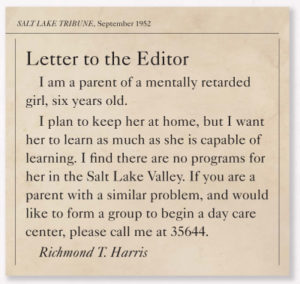
The Time to Stop Agonizing and Start Organizing
From That Went Well: adventures in Caring for My Sister, Terrell Harris Dougan, (Hyperion, 2009)
The 1960s
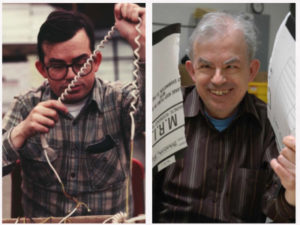 The Time to Stop Agonizing and Start Organizing
Ron Adams was one of eight students who walked through the door of the Columbus Elementary School on June 6, 1968. He was 20 years old.
The Time to Stop Agonizing and Start Organizing
Ron Adams was one of eight students who walked through the door of the Columbus Elementary School on June 6, 1968. He was 20 years old.
Ronald’s mother and father, William and Donna Adams, along with many remarkable visionary families, left an incredible legacy for children with intellectual disabilities.
They came together with a new vision for their children—where potential and independence replaced institutionalization.
The love and dedication of many families ensured that Ron had a rich, fulfilling life and a career that last nearly five decades.
June 6, 1968
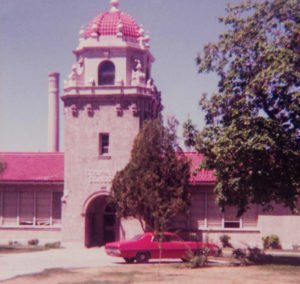 The Doors Open at the Columbus Elementary School, 2530 South 500 East
The year: 1967. There were no programs in Utah which taught any work skills to the adult retarded person. All ages were attending schools set up for small children.
The need for a workshop/work activity center…for those over 16 years old. A Board of Directors was formed from this group, adding representatives from the community who knew fundraising, public relations, and organizing volunteers…
We opened our doors June 6, 1968. There were three teachers and eight students. That was all.
Dr. Geraldine Clark, We Have Been There: A Guidebook for Parents of People with Mental Retardation (Dougan, Isbell and Vyas Associates, 1979)
The Doors Open at the Columbus Elementary School, 2530 South 500 East
The year: 1967. There were no programs in Utah which taught any work skills to the adult retarded person. All ages were attending schools set up for small children.
The need for a workshop/work activity center…for those over 16 years old. A Board of Directors was formed from this group, adding representatives from the community who knew fundraising, public relations, and organizing volunteers…
We opened our doors June 6, 1968. There were three teachers and eight students. That was all.
Dr. Geraldine Clark, We Have Been There: A Guidebook for Parents of People with Mental Retardation (Dougan, Isbell and Vyas Associates, 1979)
The 1960s:A Grassroots Movement
• Parents launched grassroots efforts that gained momentum to give their children community-based options. • Columbus opened in 1968 with 8 students and 3 teachers. • Parents lease the school from Salt Lake City School District for $1.00 a year. • Utah’s House Bill 105, passed in 1969, was one of the first state laws to pave the way to changes in public education both locally and nationally. • Access to public education gave families options for community-based educational programs.
The year: 1967
 There were no programs [in Utah] which taught any work skills to the adult retarded person. All ages were attending schools set up for small children. The need was for a workshop/work activity center for those over 16 years old. A Board of Directors was formed from this group, adding representatives from the community who knew fundraising, public relations, and organizing volunteers… We opened our doors June 6, 1968.
There were no programs [in Utah] which taught any work skills to the adult retarded person. All ages were attending schools set up for small children. The need was for a workshop/work activity center for those over 16 years old. A Board of Directors was formed from this group, adding representatives from the community who knew fundraising, public relations, and organizing volunteers… We opened our doors June 6, 1968.
There were three teachers and eight students. That was all.
— Dr. Geraldine Clark
We Have Been There:
A Guidebook for Parents of People
with Mental Retardation
The Rest of the Story
Dr. Geraldine Clark’s advocacy is respected both locally and nationally. She worked with parents to help start Columbus, but she has also worked at the state and national levels to advocate for change.
A recognized professional in the area of developmental disabilities, she helped start programs in Utah that were models for efforts that later become national in scope, including the ARC(Association for Retarded Citizens).
The 1970s: A Generation of Change
The 1970s: A Generation of Change • In 1974, Columbus was recognized as “one of the country’s leading rehabilitation and training centers” in the United States by the President’s Committee on Mental Retardation. • In 1975, Federal Public Law 94-142 guaranteed a free appropriate public education to each child with a disability. This law had a dramatic, positive impact on millions of children with disabilities across the country. • Columbus expanded its services to provide educational and vocational options for Special Education students attending Salt Lake City School District high schools. • In July 1978, Parker Hannifin was Columbus’s first business partner, a relationship that has lasted 40 years. • By 1978, Columbus had 200 participants participating in educational and vocational programs.
The Salt Lake Tribune November 3, 1974

Handicapped Students Welcome President, Show Off Wares
President Ford went back to school Saturday in Salt Lake City. All 192 current students at Columbus Community Center, 2530-5th East, a facility for physically and mentally handicapped persons 16 or over, attended classes on a regular day off (they had Friday free) to show the President their skills and just to extend greetings to the chief executive… To the excitable students— ranging from 16 to 58—the day was one of the most important in their lives. The President of the United States was “paying a call.
The Rest of the Story
When students at Columbus heard that President Ford was coming to Utah, they sent him a letter inviting him to the center. Their initiative paid off when he decided to visit Columbus during his brief visit to Utah. A year later, in October 1975, Columbus was recognized by the President’s Committee on Mental Retardation, as “one of the country’s leading rehabilitation and vocational training centers” for people with disabilities in the United States.
The 1970s
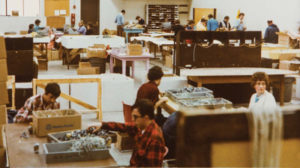 A Generation of Change through Education and Work
Columbus began to quickly expand vocational and employment programs through partnerships with local businesses, Mountain Bell signed a contract with Columbus to refurbish telephone cords, which provided a number of participants their first opportunity to receive a paycheck.
Columbus’s new electronics training program proved highly successful. Frank Chavez, pictured above, was the first person hired by Sperry Univac after he completed the electronics training program.
A Generation of Change through Education and Work
Columbus began to quickly expand vocational and employment programs through partnerships with local businesses, Mountain Bell signed a contract with Columbus to refurbish telephone cords, which provided a number of participants their first opportunity to receive a paycheck.
Columbus’s new electronics training program proved highly successful. Frank Chavez, pictured above, was the first person hired by Sperry Univac after he completed the electronics training program.
1975
 A Generation of Change through Education and Work
Within ten years of opening, Columbus grew from 8 to nearly 200 participants. Columbus, in partnership with the Salt Lake City School District and local businesses, was able to provide a variety of educational, vocational, and recreational programs.
In 1975, for the first time in history, a public school experience was available to students with disabilities ages 16-22. Parents remained involved as volunteers, but they finally had formal educational options for their children in a public school setting.
A Generation of Change through Education and Work
Within ten years of opening, Columbus grew from 8 to nearly 200 participants. Columbus, in partnership with the Salt Lake City School District and local businesses, was able to provide a variety of educational, vocational, and recreational programs.
In 1975, for the first time in history, a public school experience was available to students with disabilities ages 16-22. Parents remained involved as volunteers, but they finally had formal educational options for their children in a public school setting.
The 1980s: Embraced by the Community
• Both locally and nationally, there were efforts to create community-based programs that provided employment and residential living. • In 1981, The Salt Lake Association for Retarded Citizens worked with Columbus and the Housing Authority of Salt Lake County to open Jones Court Group Home, the first in Salt Lake County. Eight residents were welcomed by their neighbors in the Murray neighborhood. • In 1985, Columbus participant Mike Magleby is the first person in Utah to be placed in the state’s inaugural Supported Employment program. He still works today in the community. • In 1985, the International Special Olympic Games were held in Park City, Utah. Steve Bolton won a gold medal in the Giant Slalom event.
The Salt Lake Tribune November 3, 1974

Handicapped Students Welcome President, Show Off Wares
President Ford went back to school Saturday in Salt Lake City. All 192 current students at Columbus Community Center, 2530-5th East, a facility for physically and mentally handicapped persons 16 or over, attended classes on a regular day off (they had Friday free) to show the President their skills and just to extend greetings to the chief executive… To the excitable students— ranging from 16 to 58—the day was one of the most important in their lives. The President of the United States was “paying a call.
The Rest of the Story
When students at Columbus heard that President Ford was coming to Utah, they sent him a letter inviting him to the center. Their initiative paid off when he decided to visit Columbus during his brief visit to Utah. A year later, in October 1975, Columbus was recognized by the President’s Committee on Mental Retardation, as “one of the country’s leading rehabilitation and vocational training centers” for people with disabilities in the United States.
The Salt Lake Tribune March 4, 1984
 Brian Adams with his mother Donna.
Retarded Adults Eye Future
By Dawn Tracy, Tribune Lifestyle Write
When Brian Adams was learning a trade that later would enable him to get a job, he had to master social skills too. Brian 32, is mentally retarded, but he can ride the bus, grocery shop, make pottery, ski and support himself—with little supervision. [Brian and his brother, Ron, were both born with severe birth defects.] “For a longtime after our sons were born, we searched for reasons why it happened,” said [their mother, Donna Adams]. We sometimes think about how things could have been, but we’ve learned to cope to appreciate and then to fight for a place for them.
Brian Adams with his mother Donna.
Retarded Adults Eye Future
By Dawn Tracy, Tribune Lifestyle Write
When Brian Adams was learning a trade that later would enable him to get a job, he had to master social skills too. Brian 32, is mentally retarded, but he can ride the bus, grocery shop, make pottery, ski and support himself—with little supervision. [Brian and his brother, Ron, were both born with severe birth defects.] “For a longtime after our sons were born, we searched for reasons why it happened,” said [their mother, Donna Adams]. We sometimes think about how things could have been, but we’ve learned to cope to appreciate and then to fight for a place for them.
The 1980s
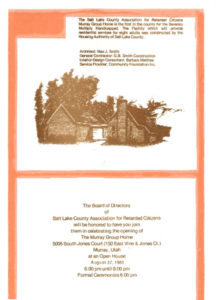 Embraced by the Community
By the 1980s, Columbus was working with families, advocates, businesses, and municipalities to embrace individuals with disabilities in every activity that many of us take for granted.
A major milestone was to provide residential living. The Salt Lake County Association for Retarded Citizens and the Housing Authority of the County of Salt Lake (HACSL) collaborated to build the Jones Court Group Home. Columbus was contracted to provide residential services at the home in “a new residency program for the severely multiply-handicapped.” Ray Morris was one of the first residents, where he still lives today.
By the end of the decade, Columbus was running a number of educational and vocational training programs. Local businesses like UPS, Mountain Bell, Westminster College, Hotel Utah, Varian/Eimac and Hercules Incorporated were providing contract work and hiring Columbus participants.
Columbus started a certified nursing assistant (CNA), car detailing, food services, and hotel services programs. Even then Governor Scott Matheson had his car detailed at Columbus and sent a thank you note complementing the team for doing an exceptional job.
Embraced by the Community
By the 1980s, Columbus was working with families, advocates, businesses, and municipalities to embrace individuals with disabilities in every activity that many of us take for granted.
A major milestone was to provide residential living. The Salt Lake County Association for Retarded Citizens and the Housing Authority of the County of Salt Lake (HACSL) collaborated to build the Jones Court Group Home. Columbus was contracted to provide residential services at the home in “a new residency program for the severely multiply-handicapped.” Ray Morris was one of the first residents, where he still lives today.
By the end of the decade, Columbus was running a number of educational and vocational training programs. Local businesses like UPS, Mountain Bell, Westminster College, Hotel Utah, Varian/Eimac and Hercules Incorporated were providing contract work and hiring Columbus participants.
Columbus started a certified nursing assistant (CNA), car detailing, food services, and hotel services programs. Even then Governor Scott Matheson had his car detailed at Columbus and sent a thank you note complementing the team for doing an exceptional job.
1975
 A Generation of Change through Education and Work
Within ten years of opening, Columbus grew from 8 to nearly 200 participants. Columbus, in partnership with the Salt Lake City School District and local businesses, was able to provide a variety of educational, vocational, and recreational programs.
In 1975, for the first time in history, a public school experience was available to students with disabilities ages 16-22. Parents remained involved as volunteers, but they finally had formal educational options for their children in a public school setting.
A Generation of Change through Education and Work
Within ten years of opening, Columbus grew from 8 to nearly 200 participants. Columbus, in partnership with the Salt Lake City School District and local businesses, was able to provide a variety of educational, vocational, and recreational programs.
In 1975, for the first time in history, a public school experience was available to students with disabilities ages 16-22. Parents remained involved as volunteers, but they finally had formal educational options for their children in a public school setting.
The 1990s: Dignity and Independence
• Families and individuals with disabilities were finding more ways to achieve personal goals and aspirations. • Columbus and other nonprofits expanded community-based supported employment and residential models to increase opportunities for independence. • Partnerships with the Utah State Office of Rehabilitation and Salt Lake County helped expand employment programs. • A record 151 individuals with disabilities completed vocational training at Columbus and become competitively employed in community jobs. Earnings were $619,860. • Columbus operated 3 residential group homes that gave those with the most severe disabilities independence to live in local neighborhoods. • In 1999, Columbus broke ground on a new, centralized campus at 3495 South West Temple.
The Decades Before Rain Man
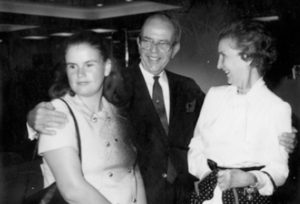 Irene, left with her father Richmond and Mother Afton as she prepares for school in California.
Richmond “Dick” Harris is recognized for his early efforts to unite families and create programs for their children with disabilities as he tried to find options for his daughter Irene, born with an intellectual disability. A little-known part of this history is that Fran Peek was working for Dick at Harris and Love Advertising when he learned that his son, Kim, had a mental disability. These two men used every creative skill they had to advocate for their children and other families. If they were alive today, they would be very proud. They had no idea they were making history.
Kim and Irene spent around eighteen years at Columbus. Irene now lives independently in her own home in Salt Lake City and enjoys her adventures around town. After the “Rain Man” won an Oscar, Kim and Fran went on to international acclaim, showcasing Kim’s skills and raising awareness about disabilities. Kim passed away in 2009 and Fran passed away in 2014.
Irene, left with her father Richmond and Mother Afton as she prepares for school in California.
Richmond “Dick” Harris is recognized for his early efforts to unite families and create programs for their children with disabilities as he tried to find options for his daughter Irene, born with an intellectual disability. A little-known part of this history is that Fran Peek was working for Dick at Harris and Love Advertising when he learned that his son, Kim, had a mental disability. These two men used every creative skill they had to advocate for their children and other families. If they were alive today, they would be very proud. They had no idea they were making history.
Kim and Irene spent around eighteen years at Columbus. Irene now lives independently in her own home in Salt Lake City and enjoys her adventures around town. After the “Rain Man” won an Oscar, Kim and Fran went on to international acclaim, showcasing Kim’s skills and raising awareness about disabilities. Kim passed away in 2009 and Fran passed away in 2014.
The 1990s
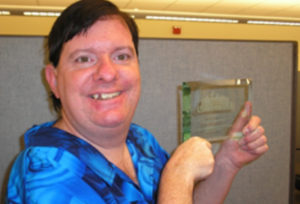 By the end of the decade, Columbus participants that started with basic educational and vocational opportunities were finding themselves with the dignity and independence that comes from having a career over a lifetime. Robert Cunningham, Anna Marie Baum, Gary Hemmert, and Wendy Sugden have built successful careers that have lasted over the decades. All are still working today in the community.
By the end of the decade, Columbus participants that started with basic educational and vocational opportunities were finding themselves with the dignity and independence that comes from having a career over a lifetime. Robert Cunningham, Anna Marie Baum, Gary Hemmert, and Wendy Sugden have built successful careers that have lasted over the decades. All are still working today in the community.
The 1990s: Dignity and Independence
 The 1990s was a decade when families began to have access to a full range of services for their children as they grew into adults. The evolution of disability-friendly public transportation providing unprecedented access to the community.
No matter the level of disability, families and individuals had options ranging from work, recreation, respite care, community activities, and independent living. This page from Columbus’s 1994 Annual Report illustrates the variety of options available during the decade.
The 1990s was a decade when families began to have access to a full range of services for their children as they grew into adults. The evolution of disability-friendly public transportation providing unprecedented access to the community.
No matter the level of disability, families and individuals had options ranging from work, recreation, respite care, community activities, and independent living. This page from Columbus’s 1994 Annual Report illustrates the variety of options available during the decade.
The Salt Lake Tribune June 16, 1996
 Fran and Kim Peek with OscarFatherhood at its PeekBy JoAnn Jacobsen-Wells
Friends say Fran Peek is one of a kind, quite possibly as unique as his son, Kim Peek—the savant who was an inspiration for the Academy Award-winning motion picture “Rain Man.”… Because of neuro-developmental brain damage...he has trouble doing such simple tasks as putting his shoes on the right feet. But... he instantly absorbs and then retrieves virtually everything he reads…. Then came “Rain Man” and Dustin Hoffman…and Kim and his father were thrust into the international spotlight. Everyone wanted to meet Kim—the living computer and perpetual calendar.
The Rest of the Story
Kim Peek was born when there were virtually no services for children who had severe disabilities. Kim’s father, Fran, was one of Columbus’s founding parents. After the success of Rain Man, Kim moved on from Columbus to share his talents around the world while raising awareness about the impact disabilities have on families.
Fran and Kim Peek with OscarFatherhood at its PeekBy JoAnn Jacobsen-Wells
Friends say Fran Peek is one of a kind, quite possibly as unique as his son, Kim Peek—the savant who was an inspiration for the Academy Award-winning motion picture “Rain Man.”… Because of neuro-developmental brain damage...he has trouble doing such simple tasks as putting his shoes on the right feet. But... he instantly absorbs and then retrieves virtually everything he reads…. Then came “Rain Man” and Dustin Hoffman…and Kim and his father were thrust into the international spotlight. Everyone wanted to meet Kim—the living computer and perpetual calendar.
The Rest of the Story
Kim Peek was born when there were virtually no services for children who had severe disabilities. Kim’s father, Fran, was one of Columbus’s founding parents. After the success of Rain Man, Kim moved on from Columbus to share his talents around the world while raising awareness about the impact disabilities have on families.
The 2000s: Aligning Social Mission with Business Enterprise
• Columbus opens its main campus in 2000, a Day Activity building in 2002, and Columbus Production Services in 2006. • Strategic emphasis on business development and partners to strengthen all programs. • Columbus Secure Shredding is started and recognized nationally as a “social enterprise” business model. • 2007 marks Columbus’s 40th anniversary with a major celebration featuring Governor Jon Huntsman as keynote speaker.
The 2000s
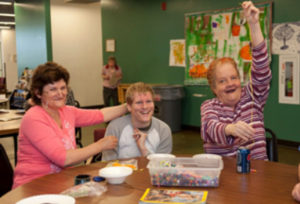 Aligning Social Mission with Business Enterprise
Aligning Social Mission with Business Enterprise
Celebrating Columbus’s Founding Parents
 Columbus celebrated its 40th anniversary in 2007. Reuniting some of the founders was a reminder that they still embody the grassroots efforts that motivated them to change the world for their children and others. Stephanie Mackay, Columbus’s foundation director, was able to join these incredible people to hear their stories. From left to right, Dr. Geraldine McCarthy Clark, Fran Peek, Donna Addams, Terrell Harris Dougan, and Arlene Dial. Dr. Clark, Mrs. Adams, and Mrs. Dial, all in their 90s today, are a testament to how one generation changed the world for their children, and for many generations following. All of Columbus’s founding families, though many are no longer with us, should be honored and celebrated for changing the world.
Columbus celebrated its 40th anniversary in 2007. Reuniting some of the founders was a reminder that they still embody the grassroots efforts that motivated them to change the world for their children and others. Stephanie Mackay, Columbus’s foundation director, was able to join these incredible people to hear their stories. From left to right, Dr. Geraldine McCarthy Clark, Fran Peek, Donna Addams, Terrell Harris Dougan, and Arlene Dial. Dr. Clark, Mrs. Adams, and Mrs. Dial, all in their 90s today, are a testament to how one generation changed the world for their children, and for many generations following. All of Columbus’s founding families, though many are no longer with us, should be honored and celebrated for changing the world.
The 2000s
 Aligning Social Mission with Business Enterprise
After a humble beginning in the old Columbus Elementary School at 2500 South 500 East, Columbus began major capital expansions that would ensure our mission and the individuals we served were integral parts of the community. With new buildings that serve several purposes, Columbus has been able to provide more options for individuals with disabilities. Columbus’s buildings reflect a commitment to be an integral part of Salt Lake County’s growing, vibrant urban community.
Aligning Social Mission with Business Enterprise
After a humble beginning in the old Columbus Elementary School at 2500 South 500 East, Columbus began major capital expansions that would ensure our mission and the individuals we served were integral parts of the community. With new buildings that serve several purposes, Columbus has been able to provide more options for individuals with disabilities. Columbus’s buildings reflect a commitment to be an integral part of Salt Lake County’s growing, vibrant urban community.
Deseret Morning News August 22, 2004
Shredding Stereotypes
By Greg Kratz, Business Editor
Steven Dial, now 50…has been a client of Columbus almost since it started. [Steven] is proud of his career accomplishment. “He’s quite capable of a lot of things,” Arlene Dial [his mother] said. “He works hard, and he earns every penny he makes. He comes home so proud. It really does something for an individual to be able to make his own way in life.
 Steven Dial at work assembling O-rings
The Rest of the Story
Forty years ago, one of Columbus’s first business contracts was with Parker Hannifin to manually assemble O-rings. This contract gave Columbus participants opportunities to learn new skills and earn a paycheck. Steven attended Columbus on its opening day in 1968. He had a career he loved assembling O-rings for 38 years until he finally retired in 2016.
Steven Dial at work assembling O-rings
The Rest of the Story
Forty years ago, one of Columbus’s first business contracts was with Parker Hannifin to manually assemble O-rings. This contract gave Columbus participants opportunities to learn new skills and earn a paycheck. Steven attended Columbus on its opening day in 1968. He had a career he loved assembling O-rings for 38 years until he finally retired in 2016.
The Deseret News July 15, 2016
Autism spectrum disorder: Tech project helps overcome the ‘social mud’ of life
By Jasen Lee
When Dylan Lamb, 24, moved to Utah from California as a child, his family was in search of educational support for his diagnosed autism spectrum disorder (ASD)…. He was able to graduate high school but still faced an uncertain adult future in a world that had little understanding or patience for people with his “invisible” disability. “Over time it was more like crawling through the ‘social mud’ that is life for an autistic person like myself,” Lamb said.
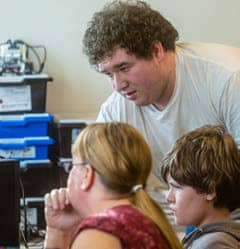 Dylan Lamb works as a peer tutor
Dylan Lamb works as a peer tutor
2018, Columbus Celebrates 50 years of serving individuals with disabilities.
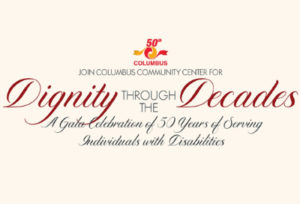 On October 26, 2018 Columbus celebrated 50 years since the humble beginnings in 1968. The celebration included a stroll through five stations of food, drinks and memorabilia representing the 50 years of Columbus’s history. Guests mingled and read about stories from the past and Columbus’ vision for the future while listening to music and entertainment which reflected five decades. Richmond T. Harris was given a Legacy Award for his efforts in 1955 to establish a program for his daughter and other children with disabilities. From those efforts, Columbus was founded in 1968. Barry Morrow, producer of the 1988 film, Rain Man was recognized for his contributions to individuals with disabilities and Parker Engineered Polymer Systems and Utah Transit Authority were also presented with Legacy Awards for their work with Columbus.
On October 26, 2018 Columbus celebrated 50 years since the humble beginnings in 1968. The celebration included a stroll through five stations of food, drinks and memorabilia representing the 50 years of Columbus’s history. Guests mingled and read about stories from the past and Columbus’ vision for the future while listening to music and entertainment which reflected five decades. Richmond T. Harris was given a Legacy Award for his efforts in 1955 to establish a program for his daughter and other children with disabilities. From those efforts, Columbus was founded in 1968. Barry Morrow, producer of the 1988 film, Rain Man was recognized for his contributions to individuals with disabilities and Parker Engineered Polymer Systems and Utah Transit Authority were also presented with Legacy Awards for their work with Columbus.
2017 – Columbus Unveils the Hub of Opportunity
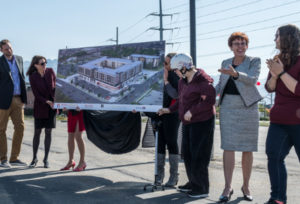 On October 10, 2017, Columbus unveiled the plan for The Hub of Opportunity, a transit-oriented, 200,000 square-foot commercial/residential development that will open in Spring of 2020. Located at 3900 S. W. Temple adjacent to the UTA Meadowbrook TRAX station in South Salt Lake, this innovative project is a community-based, mixed-use development that will bring together a unique combination of community services, workforce development opportunities, and community living for individuals with disabilities.
• The Hub will provide much-needed accessible, affordable housing: 156 total units, with 110 units designated as affordable housing and 16 units designated as a part of the NextWork Autism Transition Academy.
• It will serve as a replicable and innovative model of integration, employment, transit, and housing for individuals with disabilities.
• The hallmark of the Hub will be the NextWork Autism Center, a live/learn program for young adults with autism spectrum disorder (ASD).
On October 10, 2017, Columbus unveiled the plan for The Hub of Opportunity, a transit-oriented, 200,000 square-foot commercial/residential development that will open in Spring of 2020. Located at 3900 S. W. Temple adjacent to the UTA Meadowbrook TRAX station in South Salt Lake, this innovative project is a community-based, mixed-use development that will bring together a unique combination of community services, workforce development opportunities, and community living for individuals with disabilities.
• The Hub will provide much-needed accessible, affordable housing: 156 total units, with 110 units designated as affordable housing and 16 units designated as a part of the NextWork Autism Transition Academy.
• It will serve as a replicable and innovative model of integration, employment, transit, and housing for individuals with disabilities.
• The hallmark of the Hub will be the NextWork Autism Center, a live/learn program for young adults with autism spectrum disorder (ASD).
2019 - Deseret News
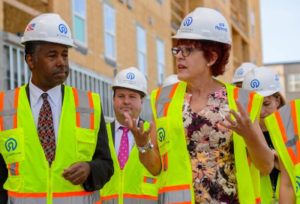 HUD Secretary Ben Carson tours Utah developments
By Lisa Riley Roche
SOUTH SALT LAKE — U.S. Housing and Urban Development Secretary Ben Carson was in Utah Thursday to tour several facilities, including a $46 million mixed-use project under construction called the Hub of Opportunity.
Wearing a hard hat and a reflective safety vest, Carson walked through part of the 200,000-square-foot complex that will include 156 apartments and an employment training center for young adults with autism. "It looks like the 22nd century," he said at one point, when shown a rendering of the planned Smith Family Foundation Sensory Room featuring lighting and textures designed to help calm and focus tenants with autism.
Built with $21 million in federal low-income housing tax credits as well as state, local and private funds, the five-story complex is scheduled to open next spring with 136 of the apartments priced for lower-income residents. "It's being built with a lot of people with disabilities in mind as well as people with low and moderate income," Carson told reporters. "It's being done in such a way that it's beautifully done. It will fit in very well with market rates." What he saw, Carson said, "kind of gets rid of a lot of the arguments" used to stop affordable housing. He said such public-private partnerships encourage upkeep and avoid the deterioration seen in federal public housing. "I think that was extremely bad for the community and particularly for the people we were trying to assist," he said, describing a reorientation of the federal government as "not just maintaining people in programs." The Hub of Opportunity "fits in very nicely with that because this is being designed in such a way that you really help people with autism spectrum disorders," he said, making "those people employable and able to fit into the general population."
HUD Secretary Ben Carson tours Utah developments
By Lisa Riley Roche
SOUTH SALT LAKE — U.S. Housing and Urban Development Secretary Ben Carson was in Utah Thursday to tour several facilities, including a $46 million mixed-use project under construction called the Hub of Opportunity.
Wearing a hard hat and a reflective safety vest, Carson walked through part of the 200,000-square-foot complex that will include 156 apartments and an employment training center for young adults with autism. "It looks like the 22nd century," he said at one point, when shown a rendering of the planned Smith Family Foundation Sensory Room featuring lighting and textures designed to help calm and focus tenants with autism.
Built with $21 million in federal low-income housing tax credits as well as state, local and private funds, the five-story complex is scheduled to open next spring with 136 of the apartments priced for lower-income residents. "It's being built with a lot of people with disabilities in mind as well as people with low and moderate income," Carson told reporters. "It's being done in such a way that it's beautifully done. It will fit in very well with market rates." What he saw, Carson said, "kind of gets rid of a lot of the arguments" used to stop affordable housing. He said such public-private partnerships encourage upkeep and avoid the deterioration seen in federal public housing. "I think that was extremely bad for the community and particularly for the people we were trying to assist," he said, describing a reorientation of the federal government as "not just maintaining people in programs." The Hub of Opportunity "fits in very nicely with that because this is being designed in such a way that you really help people with autism spectrum disorders," he said, making "those people employable and able to fit into the general population."
